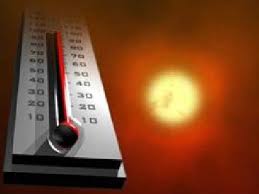By SETH BORENSTEIN AP Science Writer
WASHINGTON —
Excessive heat is the No. 1 weather killer in the United States and it’s at its most dangerous when it doesn’t cool down at night.
The current heat wave over California, Nevada, Arizona and New Mexico has temperatures hitting triple digits, with little relief at night. Hot weather is also baking the rest of the far West, including Washington, Oregon, Idaho, and parts of Utah and Montana.
Q: What’s so disturbing about this current heat wave?
A: It’s unrelenting stubbornness. There is no relief at night. Phoenix set a record for highest nighttime temperature: 91. Las Vegas has gone three days without getting below 90, according to readings at the airport.
“Nighttime heat is especially bad,” said Eli Jacks, chief of fire and public weather services at the National Weather Service. “Not to get below 90 is crazy.”
Q: What’s so dangerous about that?
If you aren’t in an air-conditioned place, “your body never has a chance to recover” at night, Jacks said. Normally the “feels-like” index – which factors in temperature and humidity – has to get to 80 degrees or below for your body to recover from the daytime heat, Jacks said.
The lack of nighttime cooling is more dangerous than the 117 degree all-time record in Las Vegas, experts said.
Q: How do heat waves compare to other weather killers?
A: In recent years, heat has been more deadly than other weather extremes in the United States.
On average, heat waves are killing about 117 people a year, according to figures from the National Oceanic and Atmospheric Administration. However, those numbers are incomplete and only based on reports during periods of extreme heat. The much more comprehensive numbers from the Centers for Disease Control and Prevention indicate that on average 658 people die each year from too much heat.
Q: Who is most at risk?
A: The elderly and children. The elderly make up 36 percent of heat deaths in the past decade, according to the CDC. And of all the excessive heat deaths, 69 percent are men. Also on average, 37 children left in car seats die from heat each year, according to a study at San Francisco State University.
Q: What can you do to stay safe?
A: Drink lots of water; the dry heat in the Southwest evaporates sweat so quickly that people don’t notice they are perspiring and get dehydrated more quickly, Jacks said. Stay in the shade and out of the heat between 10 a.m. and 4 p.m. Use sunblock of SPF 15 or higher. Wear light-colored clothing and light clothing. Reduce use of caffeine and alcohol, which tend to dehydrate, and slow down.
Q: So what’s causing all this?
A: Part of it is normal summer heat spurts, said meteorologist Kenneth James of the Weather Prediction Center in College Park, Md. But there’s another factor and that’s the jet stream.
Normally the jet stream moves generally west-to-east, but when it slows and swings dramatically to the north or south, extreme weather can happen.
What’s happening now is “a really big kink in the jet stream, about as big as you can see anytime, covering the whole western U.S.,” said heat wave expert Ken Kunkel, a professor of atmospheric sciences at North Carolina State University.
To the west of the kink, in Arizona and Nevada, there’s a high pressure system just parked there with stagnant heat, Kunkel said. And to its east are cool – even record cool – temperatures in Texas, he said.
Q: When will it end?
A: The extreme heat should continue for about a week, but it won’t set records, James said.
Q: Is this related to the deadly Arizona fire?
A: “There’s most assuredly a link” between the heat wave and the fire, Jacks said. It gets hot with extremely dry air, and then a no-rain lightning strike ignites bone-dry fuel into a fire.
Q: Is this global warming?
A: No single event can be blamed solely on man-made global warming, scientists and meteorologists say. But this is the type of heat wave than scientists have long said will be more common as the world warms.
Some, but not all, scientists also theorize that the jet stream is having more of these crazy kinks lately because of a warming Arctic and melting sea ice.
Pennsylvania State University climate scientist Michael Mann said there’s an element of randomness in the current weather. Yet with all-time heat records in the past few years being broken at three times the expected rate, he said, “there can be little doubt that climate change and global warming are playing a role.”
—
Online:
NOAA on heat waves: http://www.noaawatch.gov/themes/heat.php
NOAA beating the heat tips: http://www.noaa.gov/features/earthobs-0508/heat.html
CDC on heat waves: http://www.bt.cdc.gov/disasters/extremeheat/

